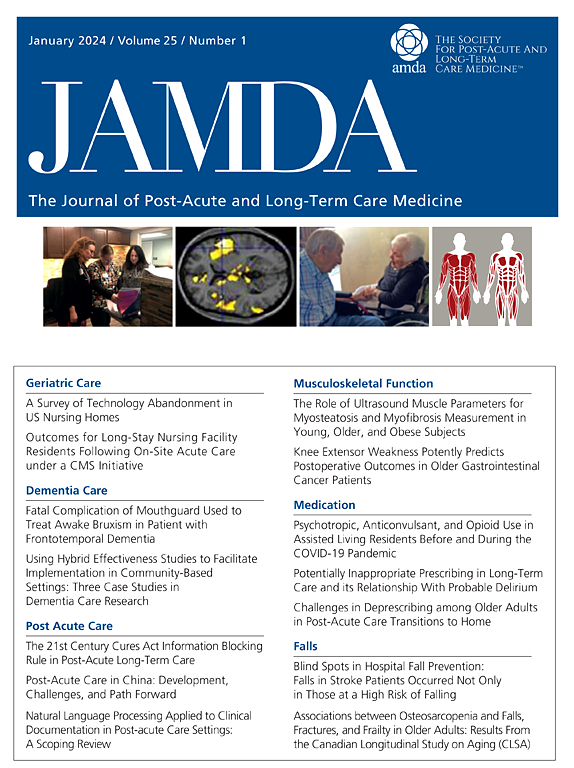Measuring Physical Activity in Hospital Settings: A Scoping Review of Randomized Controlled Trials
IF 4.2
2区 医学
Q2 GERIATRICS & GERONTOLOGY
Journal of the American Medical Directors Association
Pub Date : 2025-04-14
DOI:10.1016/j.jamda.2025.105563
引用次数: 0
Abstract
Objectives
To identify physical activity and sedentary behavior outcomes, measurement tools and protocols used, and data integrity in randomized controlled trials (RCTs) of hospital-based movement interventions in middle-aged and older adults.
Design
Scoping review of RCTs.
Setting and Participants
Adults with a mean or median age ≥50 years admitted to an acute or subacute hospital.
Methods
Four databases were searched for RCTs published between 2000 and 2023 evaluating interventions and measuring outcomes related to movement behavior (physical activity and/or sedentary behavior) of adults during an acute or subacute inpatient admission. Data extracted included movement behavior outcomes, measurement tools/devices, measurement protocols, and the integrity of movement data. Data were reported and synthesized using frequencies/percentages and via narrative summaries.
Results
After screening (n = 18,018), 34 studies were included. Most studies were conducted in subacute rehabilitation (n = 13) and excluded participants with cognitive impairment (n = 27) and/or mobility impairment (n = 24). A total of 17 different movement behavior outcomes were measured, with step count measured in 22 studies. Most studies (n = 30) measured movement behaviors using a wearable device. There were 43 unique measurement devices/tools used across studies, with significant heterogeneity observed in protocols for their use.
Conclusions and Implications
Given the substantial heterogeneity of movement behavior outcomes, and measurement tools and protocols used, there is an urgent need to develop evidence-based guidelines for measuring movement behaviors in hospital-based trials. Without this, synthesis of clinical trial outcomes and subsequent implementation of effective interventions for improving hospital-based movement behaviors will remain lacking.
测量医院环境中的身体活动:随机对照试验的范围综述。
目的:确定中老年人基于医院的运动干预的随机对照试验(rct)的身体活动和久坐行为结果、测量工具和使用方案以及数据完整性。设计:随机对照试验的范围审查。环境和参与者:在急性或亚急性医院住院的平均或中位年龄≥50岁的成年人。方法:检索2000年至2023年间发表的四个数据库的随机对照试验,评估干预措施和测量与急性或亚急性住院期间成人运动行为(身体活动和/或久坐行为)相关的结果。提取的数据包括运动行为结果、测量工具/设备、测量方案和运动数据的完整性。使用频率/百分比和叙述性摘要报告和合成数据。结果:筛选后(n = 18018),纳入34项研究。大多数研究是在亚急性康复中进行的(n = 13),排除了认知障碍(n = 27)和/或活动障碍(n = 24)的参与者。总共测量了17种不同的运动行为结果,在22项研究中测量了步数。大多数研究(n = 30)使用可穿戴设备测量运动行为。研究中使用了43种独特的测量设备/工具,在其使用方案中观察到显著的异质性。结论和意义:考虑到运动行为结果的巨大异质性,以及所使用的测量工具和协议,迫切需要制定基于证据的指导方针来测量医院试验中的运动行为。没有这一点,临床试验结果的综合和随后实施的有效干预措施,以改善医院为基础的运动行为将仍然缺乏。
本文章由计算机程序翻译,如有差异,请以英文原文为准。
求助全文
约1分钟内获得全文
求助全文
来源期刊
CiteScore
11.10
自引率
6.60%
发文量
472
审稿时长
44 days
期刊介绍:
JAMDA, the official journal of AMDA - The Society for Post-Acute and Long-Term Care Medicine, is a leading peer-reviewed publication that offers practical information and research geared towards healthcare professionals in the post-acute and long-term care fields. It is also a valuable resource for policy-makers, organizational leaders, educators, and advocates.
The journal provides essential information for various healthcare professionals such as medical directors, attending physicians, nurses, consultant pharmacists, geriatric psychiatrists, nurse practitioners, physician assistants, physical and occupational therapists, social workers, and others involved in providing, overseeing, and promoting quality

 求助内容:
求助内容: 应助结果提醒方式:
应助结果提醒方式:


